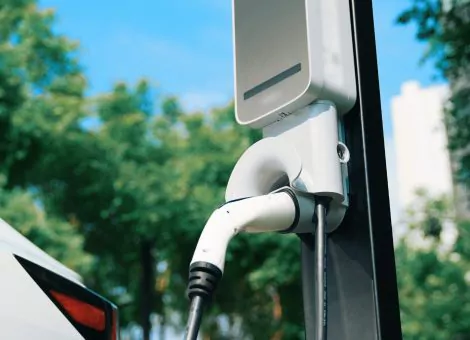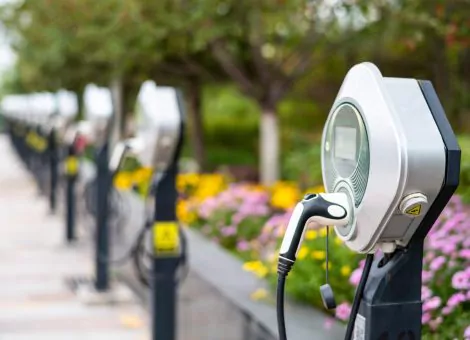Electric vehicle charging – an immediate opportunity for retailers and restaurants?
The face of the automotive industry in the U.S. is currently undergoing an accelerating sea change. At present, fewer than 5% of vehicles registered in the U.S are fully electric vehicles (EV), with Tesla representing the dominant player. However, EVs as a proportion of all new vehicles sold is projected to increase to 23% by 2025, as the combination of the U.S. government’s support for limiting carbon emissions and the increasing focus of the auto industry on EV makes itself felt. Look no further than the rapid expansion in the number of EV offerings available to consumers – in the 2020 model year there were 48 EV offerings. Looking ahead to 2024, that number jumps to 134 EV models.
One of the challenges plaguing the EV industry at present is the relative scarcity of charging stations. The U.S. currently has over 145,000 gas stations across the country, but only ~46,000 public EV stations that consist of ~115,000 individual charging ports. Further, the time required to recharge at an EV station can vary from as little as 30 minutes to as long as several hours if needing to recharge a fully depleted battery.
This increasing adoption of EVs by consumers combined with a limited current supply of charging stations represents a unique opportunity for retailers and restaurants – provide EV motorists (both existing and prospective customers alike) with charging stations on their parking lots. This can accomplish three primary goals:
- Brand loyalty – providing EV motorists with charging stations, particularly given the present lack of charging alternatives, can help drive consumer loyalty with the brand.
- Down time – when a motorist is recharging their vehicle, they are effectively a captive audience, making them more likely to engage in shopping or dining activities for as long as they are immobile.
- Revenue source – EV charging stations can represent a revenue source (although this is likely the least important of the three reasons cited).
The next obvious questions are: which retailers and restaurants should bring EV charging stations onto their parking lots, and which brick-and-mortar locations should they choose? Kalibrate, a global leader in fuel location strategies and pricing, has conducted extensive research in this area. Insights uncovered by Kalibrate as part of its own consumer research and recent EV surveys and reports include:
Motorist profile
The profile of EV drivers has been shifting over the past few years as it becomes more mainstream. Overall, EV drivers tend to be over-represented in the following areas:
- Younger – specifically, under the age of 45
- Affluent – median household income over $100,000
- Well educated – three-quarters of EV owners have at least a bachelors degree, and over 40% have a graduate degree
As such, retailers and restaurants who share these customer profile characteristics represent the most promising opportunity for EV charging stations. The EV driver profile has become somewhat more broad-based in the past 2 years, and will undoubtedly continue to do so as EV become more prevalent, but for the near term retailers and restaurants with a younger, more affluent and better educated profile have the ability to strengthen their brand imaging by providing this convenience to their customers. This will be particularly true if one or more primary competitors provide EV charging for their patrons.
Location
There are two location types that represent the most promising opportunity for EV charging stations:
- Close to home – many EV owners have charging stations at their home, rendering the need for EV charging close to their residence superfluous. However, for those EV owners who lack in-home EV charging, having stations located at establishments that they regularly patronize (such supermarkets, supercenters, coffee shops, fitness centers) can provide them with the opportunity to recharge their vehicles and concurrently encourage continued patronage at their regular haunts.
- Travel – the typical range of an EV today is less than 250 miles. As such, EV charging stations located along Interstate highways and other long-distance travel routes can provide a convenient charging option for long-distance motorists. Restaurants, outlet malls, destination retailers such as Bass Pro and Cabela’s, and regional malls represent the most obvious opportunities for EV charging.
To learn more about how Kalibrate can provide analytical insights to inform your EV opportunity, contact us to schedule an introductory discussion.
Read more articles about:
Electric VehiclesSubscribe and get the latest updates
You may unsubscribe from our mailing list at any time. To understand how and why we process your data, please see our Privacy & Cookies Policy
Related resources
Electric Vehicles
From convenience to value: Pricing strategies for the new wave of EV drivers
As electric vehicle (EV) adoption accelerates globally, the profile of the EV driver is starting to shift. In the...

Electric Vehicles
Kalibrate launches EV Pricing solution to transform electric vehicle charging operations
Launching Kalibrate EV Pricing - the intelligent EV pricing software for strategic CPOs


